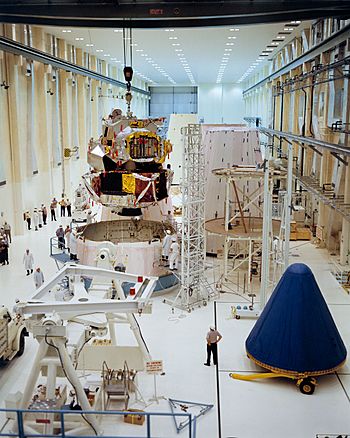Apollo 5 facts for kids

Lunar Module 1 being mated to the Spacecraft Lunar Module Adapter (SLA) in preparation for launch as Apollo 5
|
|
| Mission type | Lunar module test flight |
|---|---|
| Operator | NASA |
| Mission duration | 11 hours, 10 minutes |
| Orbits completed | 7 |
| Spacecraft properties | |
| Spacecraft | Apollo LM-1 |
| Manufacturer | Grumman |
| Launch mass | 14,360 kilograms (31,660 lb) |
| Start of mission | |
| Launch date | January 22, 1968, 22:48:09 UTC |
| Rocket | Saturn IB SA-204 |
| Launch site | Cape Kennedy LC-37B |
| End of mission | |
| Disposal | Uncontrolled reentry |
| Deactivated | January 23, 1968 9:58 UTC |
| Decay date | Ascent stage: January 24, 1968 Descent stage: February 12, 1968 |
| Orbital parameters | |
| Reference system | Geocentric |
| Regime | Low Earth orbit |
| Perigee | 162 kilometers (87 nmi) |
| Apogee | 214 kilometers (116 nmi) |
| Inclination | 31.6 degrees |
| Period | 89.5 minutes |
| Epoch | January 22, 1968 (ascent stage) |
|
|
|
Apollo 5 was an important uncrewed (no astronauts on board) test flight for the Apollo program. It was the very first time the Apollo Lunar Module (LM) was tested in space. The Lunar Module was the special spacecraft designed to land astronauts on the Moon.
Contents
What Was Apollo 5's Goal?
The main goal of Apollo 5 was to test the Lunar Module. This included checking its engines and how it would separate into two parts. The Lunar Module had two main sections:
- A descent stage to land on the Moon.
- An ascent stage to take astronauts back to orbit.
This mission was a big step towards landing humans on the Moon.
Launch and Mission Details
Apollo 5 launched on January 22, 1968. It lifted off from Cape Canaveral Air Force Station in Florida. A Saturn IB rocket carried the Lunar Module into orbit.
The mission lasted about 11 hours. During this time, the Lunar Module's engines were fired. The team also practiced separating the two stages of the spacecraft. This was a key part of how astronauts would leave the Moon.
Why Was This Test Important?
Testing the Lunar Module in space was crucial. It helped engineers make sure everything worked as planned. This flight showed that the Lunar Module was ready for future crewed missions. Even though there were some small issues, the main goals were met. The data collected helped NASA prepare for the first crewed Lunar Module flight, Apollo 9.
Images for kids
-
Apollo 5's Saturn IB on the launchpad
-
Director of Flight Operations Christopher C. Kraft (left) and Manned Spaceflight Center director Robert R. Gilruth in Mission Control during Apollo 5
See also
 In Spanish: Apolo 5 para niños
In Spanish: Apolo 5 para niños




